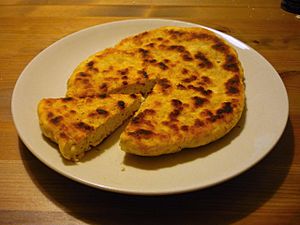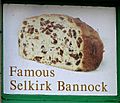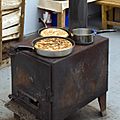Bannock (food) facts for kids
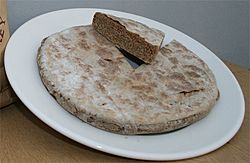
Traditional beremeal bannock, as made in Orkney, Scotland
|
|
| Type | Quick bread |
|---|---|
| Place of origin | British Isles |
Bannock is a type of flat bread. It is often round and made from grain. People usually cut a bannock into pieces before eating it.
Contents
What is Bannock?
The word "bannock" comes from old dialects in Northern England and Scotland. It might come from a Latin word, panicium, meaning "baked dough." Or it could come from panis, meaning "bread." People first used the word around the 8th century. Bannock has been a popular food in Ireland, Scotland, and Northern England for a long time. The famous Scottish poet Robert Burns even wrote about bannock in one of his poems.
How Bannock Started
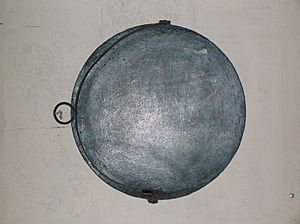
The first bannocks were thick, flat cakes. They were made from barley or oatmeal dough. This dough did not have anything to make it rise, so it was "unleavened." People shaped them into rounds or ovals. Then, they cooked them on a griddle. In Scotland, a griddle was sometimes called a girdle.
Before the 1800s, some Scottish bannocks were cooked on a "bannock stane." This was a large, flat, round piece of sandstone. It was placed right on a fire to cook the bread. Today, most bannocks use baking powder or baking soda. These ingredients make the bannock light and fluffy.
Different Kinds of Bannock
Bannocks can be different in many ways. They can be named by the type of flour used. Some are made with special ingredients. Others are named by how they are cooked. Some bannocks are even part of special celebrations.
Historically, people made special bannocks for Gaelic season changes.
- The St Bride's bannock was for spring (February 1).
- The Bealtaine bannock was for summer (May 1).
- The Lughnasadh or Lammas bannock was for autumn harvests (August 1).
- The Samhain bannock was for winter (end of October).
Many other special bannocks exist. These include beremeal bannock, bride's bannock, and Yule bannock. The Manx bonnag from the Isle of Man is similar. In Northern England, bannocks are sometimes made with pastry dough.
Selkirk Bannock
The Selkirk bannock is a very famous type from Scotland. It is named after the town of Selkirk. This bannock is soft and buttery. It is made from wheat flour and has many raisins. Some people compare it to a fruitcake.
The first known baker of this bannock was Robbie Douglas. He opened his shop in Selkirk in 1859. It is said that Queen Victoria enjoyed Selkirk bannock. She had it with her tea when she visited Sir Walter Scott's granddaughter. This helped make the Selkirk bannock very famous. Today, you can find Selkirk bannocks in many stores across Great Britain.
Bannock in North America
Bannock is also a common food among Native peoples in North America. It is known by different names, like skaan or Indian bread. You can find it in the food of the Inuit in Canada and Alaska. It is also eaten by other Alaska Natives, First Nations in Canada, Native Americans in the United States, and the Métis people.
Bannock Before European Contact?
Some people believe a type of bannock was made by Indigenous North Americans long ago. They would have used local ingredients like maize flour, roots, or tree sap. This would be similar to modern cornbread. Other sources suggest bannock came to North America from Scotland. They say it became known around the 1860s.
Many Native American tribes ate camas bulbs. These include the Nez Perce, Cree, and Blackfoot tribes. Bannock made from camas bulbs helped explorers like Lewis and Clark survive.
How Bannock is Made Today
Bannock is usually made with white or whole wheat flour. It also uses baking powder, sugar, and lard. Water or milk is added to make a dough. Sometimes, people add spices, dried fruits, or other flavors.
The dough can be cooked in different ways. It can be fried in oil or fat. It can also be baked in an oven. Another way is to wrap the dough around a stick and cook it over a fire.
Bannock and Indigenous Identity
Bannock is a very common food for Indigenous Canadians. It is eaten in many different cultural areas. However, modern bannock recipes were influenced by government food given to Indigenous people. This happened in the late 1800s on reserves. At that time, Indigenous people had less access to their traditional foods.
The government rations included foods like wheat flour, sugar, lard, and butter. These were high-calorie foods that could be stored for a long time. These new ingredients helped Indigenous people survive. Today, some people see bannock as a part of Indigenous identity. For others, it reminds them of the difficult changes brought by colonization.
Bannock was once a practical food for travel and work. It became a necessary food for Indigenous families. It helped them avoid starvation when they lost their traditional food sources. This happened because of the reservation system. On reserves, traditional hunting and farming were replaced by government food. This often included flour and lard.
This policy led to a loss of knowledge about traditional edible plants. Wheat and flour became part of Indigenous bannock recipes. This changed the nature of the bread. Modern bannock, like other processed foods, can contribute to health problems. These include diabetes and obesity among Indigenous people.
See also
 In Spanish: Bannock (comida) para niños
In Spanish: Bannock (comida) para niños


